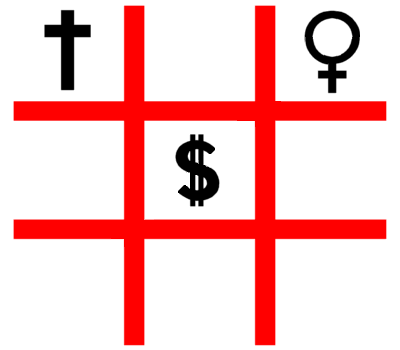
|
Excerpts fromPrisoner’s DilemmaWilliam Poundstone |
SHUBIK’S DOLLAR AUCTION
In their free time, Martin Shubik and colleagues at RAND and Princeton tried to devise new and unusual games. According to Shubik, the central question was, “Can we get certain pathological phenomena as well-defined games?” They wanted games you could actually play. “I don’t believe any game that can’t be played as a parlor game,” Shubik told me.
In 1950, Shubik, John Nash, Lloyd Shapley, and Melvin Hausner invented a game called “so long sucker.” This is a vicious game, played with poker chips, where players have to forge alliances with other players but usually have to betray them to win. When tried out at parties, people took the game seriously. (“We had married couples going home in separate cabs,” Shubik recalls.)
Shubik posed the question of whether it was possible to incorporate addiction in a game. This question lead to the dollar auction. Shubik is uncertain who thought of the game first or whether it was a collaboration. In any case, Shubik published it in 1971 and is generally credited as the game’s inventor.
In his 1971 paper, Shubik describes the dollar auction as an “extremely simple, highly amusing and instructive parlor game.” A dollar bill is auctioned with these two rules:
1. (As in any auction) the dollar bill goes to the highest bidder, who pays whatever the high bid was. Each new bid has to be higher than the current high bid, and the game ends when there is no new bid within a specified time limit.
2. (Unlike at Sotheby’s!) the second-highest bidder also has to pay the amount of his last bid – and gets nothing in return. You really don’t want to be the second-highest bidder.
Shubik wrote, “A large crowd is desirable. Furthermore, experience has indicated that the best time is during a party when spirits are high and the propensity to calculate does not settle in until at least two bids have been made.”
Shubik’s two rules swiftly lead to madness. “Do I hear 10 cents?” asks the auctioneer – “5 cents?”
Well, it’s a dollar bill, and anyone can have it for a penny. So someone says 1 cent. The auctioneer accepts the bid. Now anyone can have the dollar bill for 2 cents. That’s still better than the rate Chase Manhattan gives you, so someone says 2 cents. It would be crazy not to.
The second bid puts the first bidder in the uncomfortable position of being the second-highest bidder. Should the bidding stop now, he would be charged 1 cent for nothing. So this person has particular reason to make a new bid – “3 cents.” And so on
Maybe you’re way ahead of me. You might think that the bill will finally go for the full price of $1.00 – a sad comment on greed, that no one got a bargain. If so, you’d be way too optimistic.
Eventually someone does bid $1.00. That leaves someone else with a second-highest bid of 99 cents or less. If the bidding stops at $1.00, the underbidder is in the hole for as much as 99 cents. So this person has incentive to bid $1.01 for the dollar bill. Provided he wins, he would be out only a penny (for paying $1.01 for a dollar bill). That’s better than losing 99 cents.
That leads the $1.00 bidder to top that bid. Shubik wrote, “There is a pause and hesitation in the group as the bid goes through the one dollar barrier. From then on, there is a duel with bursts of speed until tension builds, bidding then slows and finally peters out.”
No matter what the stage of the bidding, the second-highest bidder can improve his position by almost a dollar by barely topping the current high bid. Yet the predicament of the second-highest bidder gets worse and worse! This peculiar game leads to a bad case of buyer’s remorse. The highest bidder pays far more than a dollar for a dollar, and the second-highest bidder pays far more than a dollar for nothing.
Computer scientist Marvin Minsky learned of the game and popularized it at MIT. Shubik reported: “Experience with the game has shown that it is possible to ‘sell’ a dollar bill for considerably more than a dollar. A total of payments between three and five dollars is not uncommon.” Possibly W. C. Fields said it best: “If at first you don’t succeed, try, try again. Then quit. No use being a damn fool about it.”
Shubik’s dollar auction demonstrates the difficulty of using von Neumann and Morgenstern’s game theory in certain situations. The dollar auction game is conceptually simple and contains no surprise features or hidden information. It ought to be a “textbook case” of game theory.
It ought to be a profitable game, too. The game dangles a potential profit of up to a dollar in front of the bidders, and that profit is no illusion. Besides, no one is forced to make a bid. Surely a rational player can’t lose. The players who bid up a dollar to many times its value must be acting “irrationally.”
It is more difficult to decide where they go wrong. Maybe the problem is that there is no obvious place to draw the line between a rational bid and an irrational one. Shubik wrote of the dollar auction that “a game theory analysis alone will probably never be adequate to explain such a process.”
William Poundstone, Prisoner’s Dilemma, Doubleday, NY 1992, pp. 280-282.